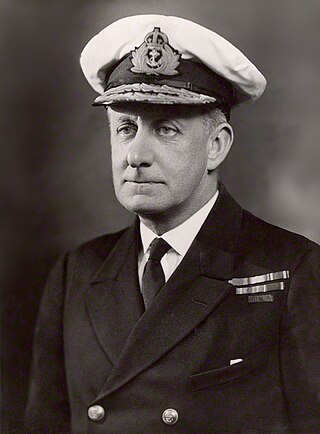
Vice Admiral Sir Geoffrey Schomberg Arbuthnot, was a senior officer in the Royal Navy.

The Commander-in-Chief, The Nore, was an operational commander of the Royal Navy. His subordinate units, establishments, and staff were sometimes informally known as the Nore Station or Nore Command. The Nore is a sandbank at the mouth of the Thames Estuary and River Medway. In due course the Commander-in-Chief became responsible for sub-commands at Chatham, London, Sheerness, Harwich and the Humber.

The Commander-in-Chief, Portsmouth, was a senior commander of the Royal Navy for hundreds of years. The commanders-in-chief were based at premises in High Street, Portsmouth from the 1790s until the end of Sir Thomas Williams's tenure, his successor, Sir Philip Durham, being the first to move into Admiralty House at the Royal Navy Dockyard, where subsequent holders of the office were based until 1969. Prior to World War I the officer holder was sometimes referred to in official dispatches as the Commander-in-Chief, Spithead.

Admiral Sir Clement Moody, was a Royal Navy officer who served as Commander-in-Chief, East Indies Fleet, from 1945 to 1946 and Commander-in-Chief, South Atlantic, from 1946 to 1948.

The Flag Officer Scotland and Northern Ireland (FOSNI) was a senior post in the Royal Navy of the United Kingdom. It was based at HM Naval Base Clyde, and the holder of the post was the Royal Navy’s senior officer in Scotland. The post of FOSNI, dating from 1946, was re-scoped and re-named in 1994 to Flag Officer Scotland, Northern England & Northern Ireland (FOSNNI), then named back in 2015, before being dis-established in 2020.

The Eastern Fleet, later called the East Indies Fleet, was a fleet of the Royal Navy which existed between 1941 and 1952.
The Commander in Chief, Dover was an operational commander of the Royal Navy. His subordinate units, establishments, and staff were sometimes informally known as the Dover Command.

The Plans Division was the former war preparation and wartime strategic planning arm of the Admiralty Department from 1917 to 1964, The division originally became the main policy advisory and formulating body to the Chief of the Naval Staff. It later came under the supervision of the Assistant-Chief of the Naval staff (Policy).
The Commodore-in-Charge, Algiers was an administrative shore based appointment of the British Royal Navy established during World war II who was responsible for the berthing of all British convoys in Algeria and its sub-commands, facilities and staff from 1942 to 1946. The post holder was based at Allied Force Headquarters, Algiers. It was at first a sub-command of the Commander-in-Chief, Mediterranean Fleet then later the Commander-in-Chief, Levant.

The Rear-Admiral, Alexandria was an administrative shore based appointment of the British Royal Navy. The post was established during the Second World War, subordinate to the Commander-in-Chief, Mediterranean Fleet then later the Commander-in-Chief, Levant.

During the First World War, the Commander-in-Chief at the Cape, Rear Admiral Herbert King-Hall, expended much effort to destroy the elusive German light cruiser Königsberg.
The Flag Officer-in-Charge, Humber was a Royal Navy officer who administered naval forces located at Immingham and Grimsby, Lincolnshire, England. His formation was sometimes known as the Humber Station or Humber Area. In World War I it was a sub-command of the Admiral of Patrols from 1914 to 1916, then came under the Commander-in-Chief at the Nore until 1921. In World War II the FOIC was responsible to the Commander-in-Chief, The Nore.
The14th Destroyer Flotilla, or Fourteenth Destroyer Flotilla, was a naval formation of the British Royal Navy from April 1916 to 11 February 1919 and again from 1 June 1940 to January 1944.

The Red Sea Station was a military formation of the Royal Navy. At various times it has also been referred to as Egypt Division and Red Sea and later the Red Sea and Canal Area. The Royal Navy had distinct formations for the Red Sea at intervals from 1846 until circa 1944-45.

The Naval Officer-in-Charge, Aden, was an administrative appointment of British Royal Navy originally established in 1839 as the Senior Naval Officer, Aden. He was responsible for HMS Sheba. It was a sub-command of the Flag Officer, Middle East.
The Rear-Admiral, Training Establishment Mediterranean was an command appointment of British Royal Navy established during World war II who supervised the training base HMS Canopus at Alexandria, Egypt He was subordinate to the Commander-in-Chief, Mediterranean Fleet.
The Senior British Naval Officer, Suez Canal Area was an administrative appointment of the Royal Navy established during World war II who was responsible for the naval base HMS Stag at Ismailia, Egypt. The SBNO was subordinate to the East Indies Station from 1939 to 1941 then the Mediterranean Fleet until 1942.

British Naval Forces Germany was a command of the Royal Navy that was active from 1944 to 1961 under three titles.
James Murray Pakenham Pipon KBE CMG MVO was a Royal Navy officer who served in World War I and, after being recalled to active duty in 1940, World War II.






